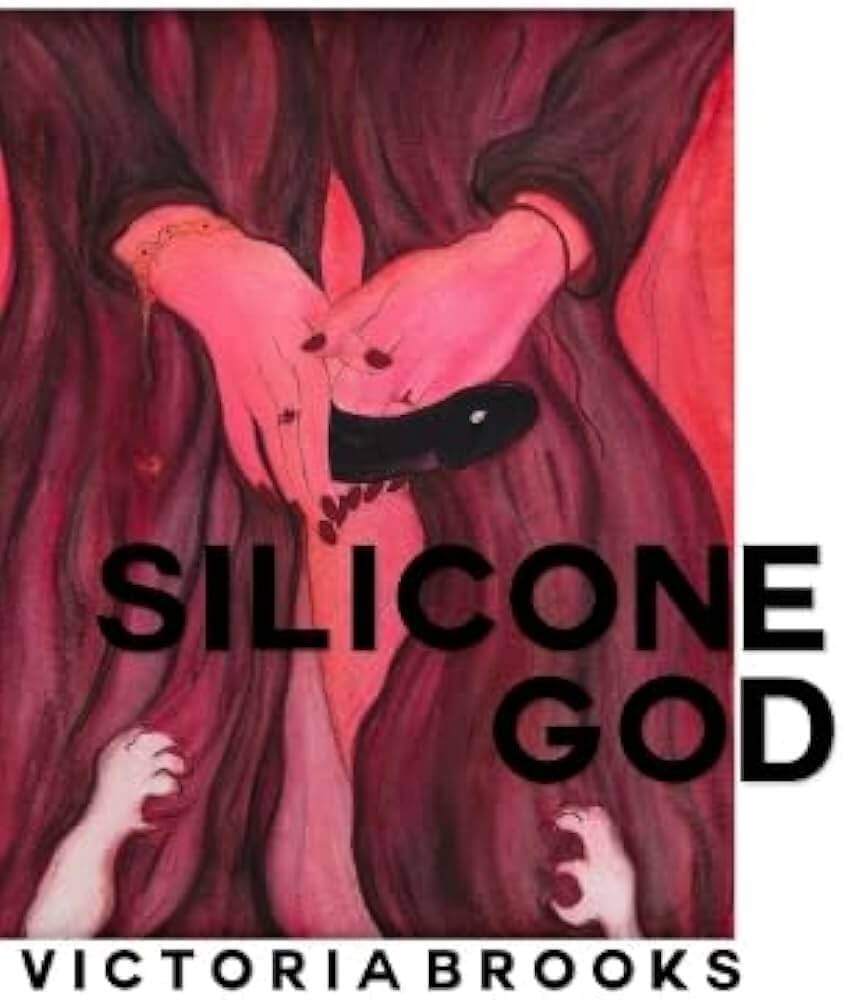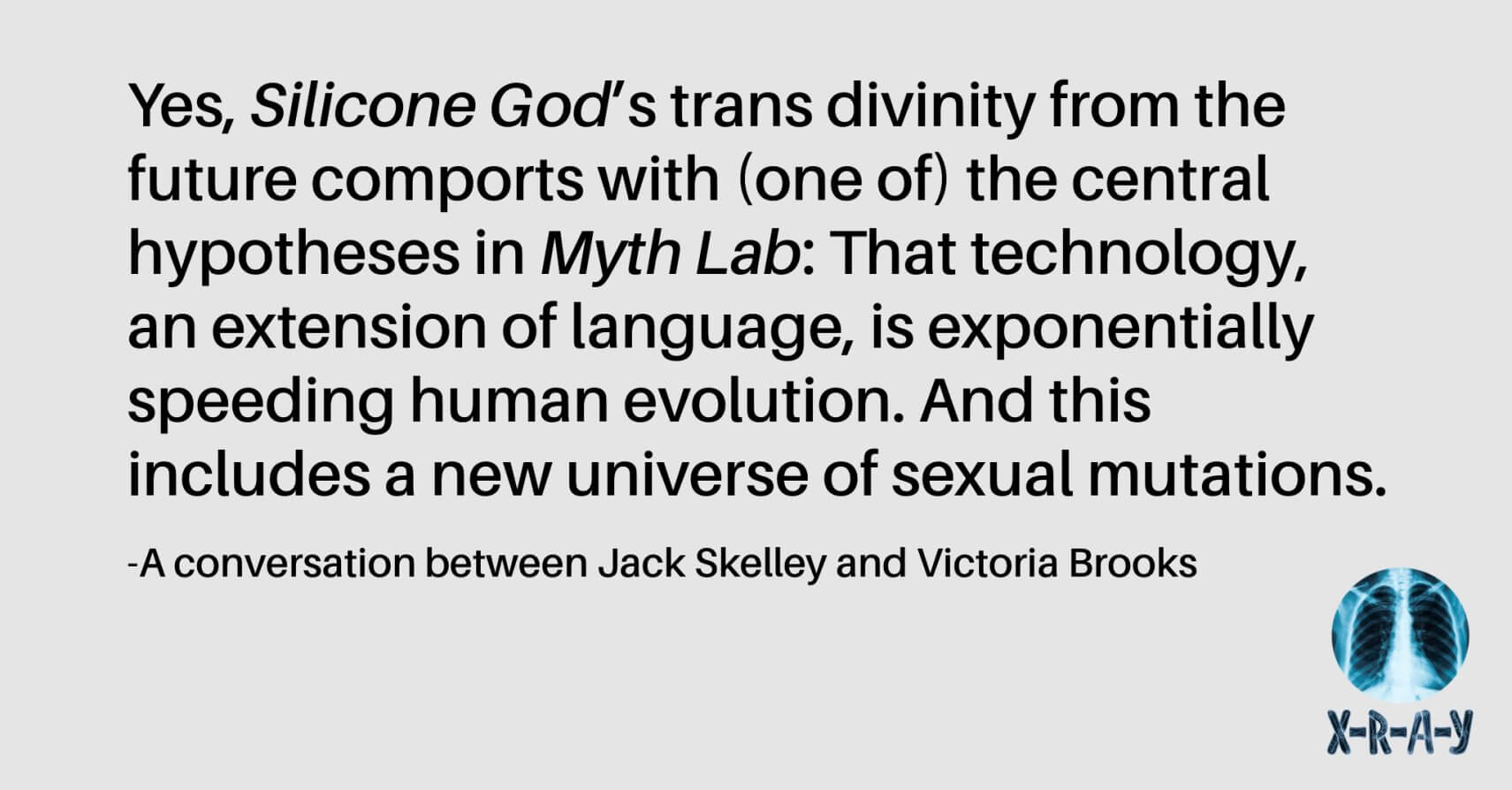Two freaky fiction writers chat. Jack Skelley, author of The Complete Fear of Kathy Acker (Semiotext(e), 2023) joins Victoria Brooks, author of Silicone God (Moist, 2023). Fear of Kathy Acker is a cult hit embraced by young readers. Skelley’s new book of stories is Myth Lab (Far West Press, 2024). Silicone God is a strange strain of post-human, science fiction/body horror by “Queer Mistress Wife Human” (Brooks’ Instagram name). Topic A: How horny writing may reach beyond tired categories of sexual and textual orientation.


Jack: I’ll kick it off! Victoria, I was first attracted to Silicone God for its boundary blurring. Your debut novel straddles genres, becoming larger than its many parts: It’s billed as “queer sci-fi” but also subsumes body horror, perhaps auto-fiction, and ventures into themes such as species evolution (which my new book Myth Lab does too!) At the same time, its (very horny!) narrative messes with the sexual orientation of its protagonist. In fact, the novel messes with the very concept of time and narrative. Can you encapsulate how and why you do this?
Victoria: In terms of why, I don’t think I can do otherwise. It’s all a mess: me, bodies, sexual orientation and gender. Sex. Time. I tried to reflect this in Silicone God. But I always feel like I’m fighting between letting the mess in and keeping it out – deciding which false coherences I’ll accept. Choosing genres and drawing straight lines is hard because mess is fucking fun. And when the mess is sex, it’s horny! This, especially in the case of writing like ours that mixes genres, including auto-fiction, can leave the reader with questions about what’s real and what isn’t. My writing (my nonfiction work and my sci-fi) draws on aspects of my life, but I like to play with the reader. I want them to wonder. I think it’s sexier to read a hot scene and think maybe it actually happened. Myth Lab also embraces the mess (or the blur) in such a beautifully wild and sexy way – I’d love to know more about why you’re also drawn to this mode of writing.
Jack: I get what you said about “deciding which false coherences I’ll accept,” because so many coherences are merely imposed norms. Including sexual norms, of course. Myth Lab goes crazy messing (as you say) with depictions of sexual orientations and genders. For example, it portrays booming transgender medical procedures as advancements in human evolution. Hormone replacement therapy (HRT), silicone implants (breasts, butts and beyond), and “neurodivergent” approaches to sexual orientation are all celebrated in Myth Lab’s mish-mash mess. Rather than in traditional story form, it does this via mock-academic “theories,” and other genre perversions. I think Silicone God does a parallel thing. But in (mostly) narrative mode. Here’s a freaky paragraph from your book:
My little suckers cupped her skin – the slimy hot and cold sensations sending her wild. I put one on her clit, and carefully engorged it with blood so much that it became a mini cock. She begged me to kiss it till she came.
The sexy mess is so messy that the quaint term “bisexual” doesn’t begin to cover the book’s realms of trans-species sex. And trans-temporal sex! So let me confront you with the (admittedly reductive) question your readers have: How much of Silicone God is based in your personal experience?
Victoria: I love how we converge on the point about transness: in Silicone God, there is a divine trans character (created by mushroom gods 3000 years in the future). Myth Lab‘s theories give me life, and more specifically give life to my drive to see sex on the page. Your text takes the form of so many dimensions of a sex life. We have the hallucinogenic poetic parts with lines like: “Where voice and vagina conflate, you’ll find kisses promise more illicit pleasures. The Other’s voice cajoles, seduces, instructs, creating the one hundred-letter word for thunder….” Then later, a switch to a more linear prose—one of my favourite parts is a short meditation on the erotics of gel nails—then to the tender: “How I yearn to hold and heal. How, upon cumming, I laugh uncontrollably. How, later or at any time, I weep at the most maudlin nonsense. A detergent commercial.”
It also gives me joy to see your creative destruction of academic or philosophical authority over sex. I feel we have a similar drive in our writing to understand something, or grasp at a truth about sex (that maybe exists beyond our own words) and do something wild with it. To your question: it’s hard to distinguish where I stop, and Silicone God begins. Even the scenes taking place in a future dimension called Time ruled by mushroom gods. Now, if the question is rather: Are there scenes that are written directly from experience? Yes. My book gives dramatic color to my thinking around the mistress archetype, and I have been a mistress many times. So some of the tougher scenes (and some of the hot ones) are direct from experience. So I’ve paired the very real, with the outright unreal. I wonder why. Does Myth Lab have a theory? Does it do the same?
Jack: Yes, Silicone God’s trans divinity from the future comports with (one of) the central hypotheses in Myth Lab: That technology, an extension of language, is exponentially speeding human evolution. And this includes a new universe of sexual mutations. I sort-of summarize that in this line from the Myth Lab “theory” titled “Rendezvous with God-MILF”: “If DNA is evolution’s hardware, language is its software, and dirty talk does most of the coding.” Many of these ideas derive from Terence McKenna, the psychedelic shaman who postulated that pre-human evolution was jump-started by a metaphysical intervention from psilocybin mushrooms. So there’s another connection between your novel and my stories! Magic fungi! Towards the end of Silicone God, the narrator has this bizarre epiphany:
When I first saw the Sea of Time, I thought it looked like heaven. It was a heaving mirror, the same color as the violet sunset and the silica under my feet. Massive cock-shaped mushrooms poked up among the dunes….
Setting aside the phallic symbolism of mushrooms, Let me ask you this: You’ve already acknowledged having been a multiple mistress. Do you also have experience with magic mushrooms? Or what is the source of your mushroom god imagery?
Victoria: We’ve coincided with mushrooms: magic! I’m excited that you mention one of my favorite scenes in Silicone God. I have certainly had my fair share of psychedelic experiences, but the source of the imagery is rather the evolution and physicality of mushrooms themselves. I find it extraordinary that their mycelium underground networks have helped trees secretly communicate; even flirt with one another. And as a queer person who believes fiercely in activism, I adore this. Perhaps it’s even brought together our books!
I’m also interested in the analogy of the mycelium and the mistress, and how she becomes a mode/body of communication between wives (or indeed between wives and husbands, and with other mistresses). That’s where I was going with the scene you mention: the mirror sea (made of mistresses) nourishes the mycelium which is the network connecting the mushroom fruit bodies. I feel like we could keep on talking about this (and our mycelium line of communication will certainly continue) but perhaps we can wrap things up here with my question to you about imagery in general. I feel like our approaches to imagery are similar, although in Myth Lab I was struck by how skillfully you managed to evoke so many hallucinogenic scenes. This, for many reasons, is one of my favorites: “It suggests that James Joyce’s mistress ululates her uvula. It flutters with ovulations in the ‘Linguaverse,’ as you might call it. The ultimate sex worker, this super uterus is formed by subtracting her slave names from her pet names, and hiero-symbols in doublewide quasar waterways.” I’m curious about the experiences and/or processes that have resulted in such poetic alchemy?
Jack: These “theories” are intertextual: They are inspired by what I’m reading and hearing. I quote from other books, and each story ends with a list of sources. I blend them with personal compulsions to arrive at a third place: linguistically based with lots of dumb puns and pop-culture references. This is my go-to high/low synthesis. Myth Lab mixes everything from Kim Kardashian and TikTok to C.G. Jung and Noam Chomsky. Plus a bunch of mythology, romance and sex, including sex-worker material. It’s fun to write, and – one hopes! – to read.

